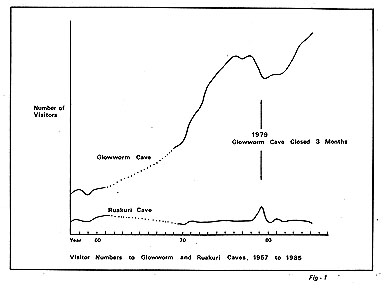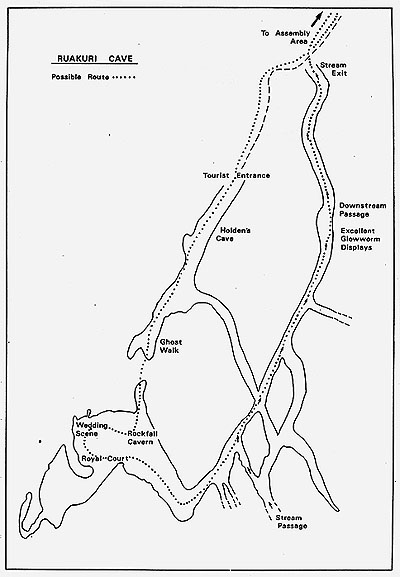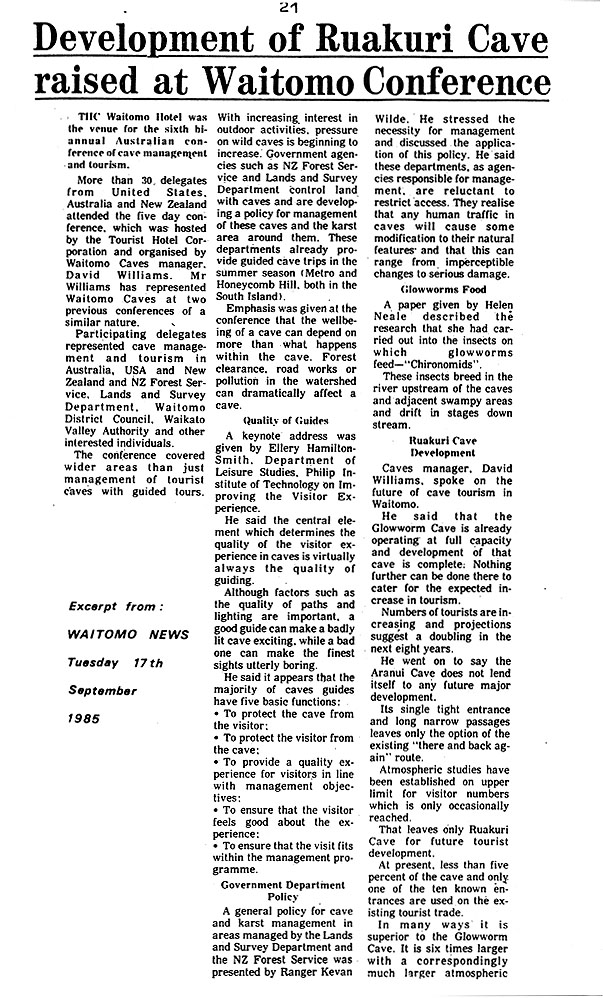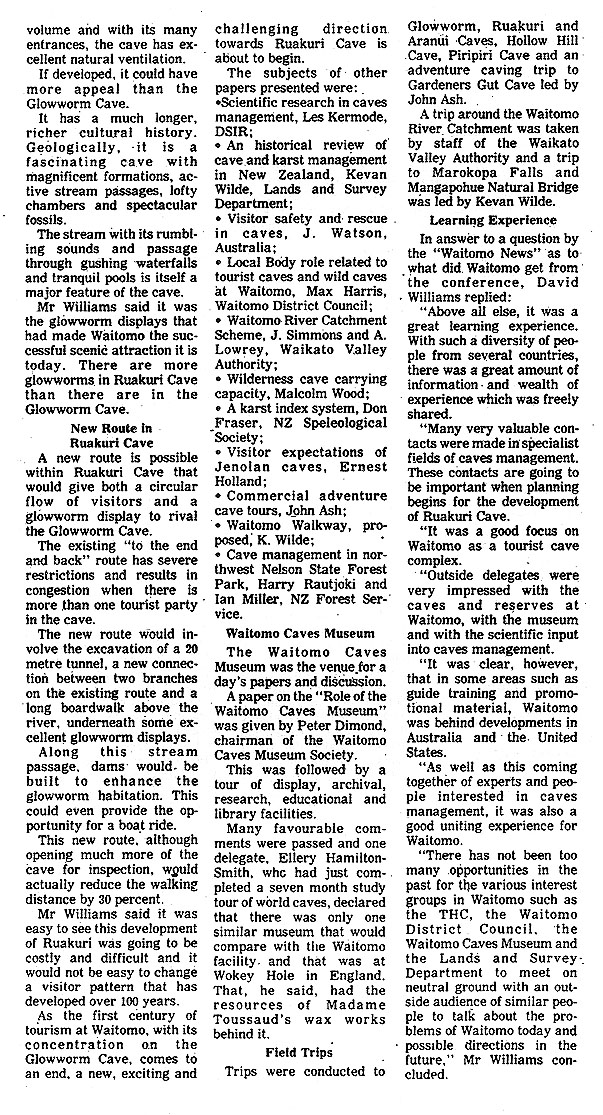THE FUTURE OF CAVE TOURISM IN WAITOMO
In December 1987 Waitomo celebrates 100 years of cave tourism. Taane Tinorau and Fred Mace, the first visitors to explore the caves at Waitomo, had no idea back in 1887 that as they nervously poled their flaxwood raft into the stream entrance of the Glowworm Cave they were beginning a process of cave exploration, development and commercialisation that was to culminate a century later in one of New Zealand's best known and admired scenic attractions. Almost immediately after the first exploration, calls were made for the protection of the cave and this protection it was believed could only be guaranteed by state control and development for tourism. The process of acquiring the land around Waitomo took another fourteen years. Ruakuri Cave was already under state owned land and when Aranui Cave was discovered nearby in 1910 the state now owned a magnificent complex of caves and several hundred acres of scenic reserves and farm land.
Despite the early enthusiasm of the addition of Ruakuri and Aranui Caves to the Waitomo complex it was realised by the early 1920s that with the improvements in transportation most visitors only wanted to see the Glowworm Cave and did not want to stay overnight. A trend was already developing which was later to cause severe problems. At the same time the emphasis on development was on presentation rather than preservation, electric lighting was installed in the Caves in 1926, everybody agreed this was a great improvement, even the green growth appearing in walls and formations around the lights added "colour" to the caves.
By 1952 however it was becoming apparent that the management of the caves was more involved than previously thought. The preservation of the caves depended on more than just the State's control and development for tourism. The removal of natural vegetation above the Glowworm Cave and from the catchment upstream was causing problems, the Glowworm Cave was drier and there seemed to be an increase in flooding and silt build-up within the cave. The Glowworm Cave only trend continued, in 1957 only 40% of visitors to Waitomo saw all three caves. In the 1970s the numbers of people visiting the Glowworm Cave had increased so much that overcrowding itself was considered a serious problem, there was noticeable decline in both the quality of the cave atmosphere and the visitor's cave experience.
Atmospheric studies had shown that carbon dioxide exhaled by cave visitors was accumulating in some parts of the cave causing corrosion to formations and posing a health risk to visitors themselves. Cave temperatures had also increased because of the addition of body heat and heat from the lighting system. The extra lighting required also meant that lampenflora covered most of the cave. Clearly the cave itself was under stress from too many visitors.
As the number of people visiting the Glowworm Cave increased (Fig 1) there was a corresponding decline in the visitor's cave experience. It was indeed unfortunate that large numbers of people were seeing the cave in the worst possible way - crowded. With up to 2,000 people a day visiting the Glowworm Cave and up to 400 people in the cave at one time it was impossible to maintain a high standard of guiding. There was also an increase in the people problems of accidents, claustrophobia, vandalism and souveniring.
In 1975 the Waitomo Caves Scientific Research Program was set up. The objectives of the program were to gain a greater understanding of the resource and to put the management of the caves on a secure scientific foundation. The Research Committee instigated and supervised a decade of very intense research and the implementation of research recommendations. At the height of this research activity an event occurred that demonstrated to everyone the extreme vulnerability of Waitomo based as it is on a delicate and simple form of life found in one of its caves. In early 1979 the glowworms in the Glowworm Cave turned off their lights and for the first time in its long history of service the cave was closed indefinitely. Ironic as it may seem now but that event can be related back to an implementation of an earlier research recommendation five years before. If ever there was a lesson in the complexities of cave management it was surely learned in the years around this time. The Glowworm Cave re-opened three months later and research continues to this present day. It is now safe to say that the Research Program has largely achieved its goal and that the management of the caves is now on a safer scientific footing.
The problem of overcrowding and congestion in the Glowworm Cave began to decline after 1976. In that year visitor numbers peaked but then started to decline as the world economy began to recede under the impact of oil price rises. At that time 48% of all visitors to the caves were from overseas (that proportion is around 60% today). Cave tour times were extended with the cave open from 9.00am to 9.00pm in summer. In 1979 a new tourist exit to the cave was developed which created a near circular route and that section of the cave which was at risk from CO2 accumulation was closed off when visitors reached an hourly limit. The closure of the cave in 1979 and the resulting bad publicity further deflated visitor numbers and it was not until last year that numbers caught up and exceeded the 1976 peak. Numbers are again increasing and projections suggest a doubling in the next eight years. Development within the Glowworm Cave is complete, nothing further can be done there to cater for this expected demand. The cave is already operating at full capacity.
We have noted that as early as the 1920s most visitors to Waitomo were content to see only the Glowworm Cave and that by 1957 only 40% saw all three caves. In 1985 that figure is 7%. Several reasons account for this imbalance in the use of the three caves:
- The boat ride through the Glowworm Grotto is indeed a spectacular cave experience considered by most visitors to Waitomo as a "must".
- Extra time, effort and cost is involved to see the other two caves. It takes at least another two hours walking, another twenty minutes driving time and costs twice as much to see all three caves.
- There is the impression that what you see in the Aranui and Ruakuri Caves you also see in the Glowworm Cave. Caves suffer very much from the attitude "seen one, seen them all".
Management practice over the, century has not discouraged this imbalance. Almost all promotion of Waitomo Caves has concentrated on the Glowworm Grotto boat ride. The demand for the Glowworm Cave has been catered for by increasing the availability of tour times. From 1960 to 1985 the number of daily inspections at Ruakuri Cave increased from three to five and in the Glowworm Cave from six to forty. During this same period the number of people visiting the Glowworm Cave increased 456%, the visitors to Ruakuri actually declined.
This imbalance in the use of the three tourist caves which sees the Glowworm Cave over-utilised and Ruakuri and Aranui Caves under-utilised must be recognised as the last and most challenging of the major management problems that yet remains unsolved. Clearly a new direction is needed and with the focus on Waitomo this conference brings and our centenary two years away it is indeed timely to outline a possible direction. Our attention must shift to Aranui and Ruakuri Caves. Aranui Cave does not lend itself to any further major development. Its single, tight entrance and long narrow passages leaves only the option of the existing "there and back" route. Atmospheric studies have established an upper limit for visitor numbers which very occasionally is reached. That leaves Ruakuri Cave.
Ruakuri Cave is ideal for further development. At present less than 15% of the cave and only one of the ten known entrances are used on the existing tourist route. In many ways it is superior to the Glowworm Cave. It is six times larger with a corresponding much larger atmospheric volume and with its many entrances the cave has excellent natural ventilation. If developed it could have more appeal than the Glowworm Cave. It has a much longer, richer cultural history. Geologically it is a fascinating cave with magnificent formations, active stream passages, lofty chambers and spectacular fossils. The stream with its rumbling sounds and passage through gushing water-falls and tranquil pools is itself a major feature of the cave. We all know that it is the glowworm displays that have made Waitomo the successful scenic attraction it is today; there are more glowworms in Ruakuri Cave than there are in the Glowworm Cave.

Figure 1: Visitor Numbers to Glowworm and Ruakuri Caves. 1957 to 1985
A new route is possible within Ruakuri Cave that would give both a circular flow of visitors and a glowworm display to rival the Glowworm Cave. The existing "to the end and back" route has severe restrictions and results in congestion when there is more than one tour party in the cave. The new route would involve the excavation of a twenty metre tunnel, a new connection between two branches on the existing route and a long boardwalk above the river underneath some excellent glowworm displays. Along this stream passage dams would be built to enhance the glowworm habitat this may even provide the opportunity for a boat ride. This new route although opening much more of the cave for inspection will actually reduce the walking distance by 30%. (Figure 2 & 3)
Even the outside environment around Ruakuri Cave surpasses the Glowworm Cave in terms of scenic appeal and cave protective cover. The cave is located under one corner of Ruakuri Bush Scenic Reserve. This is one of the largest areas of North Island karst left in its natural state and provides good protection for the natural cave processes within Ruakuri. Further additions to the Reserve are possible that would extend this cover. The bush itself is a magnificent scenic and recreational resource and less than ten minutes walk from Ruakuri Cave is another magnificent natural karst feature, the Ruakuri Natural Bridge. This spectacular open cave with a large upstream entrance and waterfall exit lends itself superbly as a self-guided interpretative walk, an ideal complement to a tour of Ruakuri Cave. Its development is being evaluated at this moment as part of greater Waitomo Walk which includes not only the building of an aerial walk through the Natural Bridge but the establishment of a walking link across rolling farmland back to Waitomo Caves Village. Other outside developments will be needed near Ruakuri Cave. These include upgrading and extending the roads and vehicle parking areas and a new visitor centre with facilities on a greater scale than at the Glowworm Cave.
It is easy to see that this development of Ruakuri is going to be costly and difficult and it is not going to be easy to change a visitor pattern that has developed over 100 years. Development must assure a visitor experience that at least rivals the Glowworm Cave and that requires less effort to see Ruakuri than it does now. Tours through Ruakuri Cave will have to be made readily available, at least on the hour, at the same time visitors to the Glowworm Cave will be restricted under a strict booking system. Recommendations from the Research Study Group suggest a maximum of 200 people per hour only allowed in the Glowworm Cave. Below this number the risk to the cave is reduced at the same time the visitor experience is maintained. Visitors to Waitomo will have the option of waiting perhaps several hours to see the Glowworm Cave or to see Ruakuri Cave almost immediately.
Promotion and publicity will attempt to change people's awareness of Waitomo away from the Glowworm Cave and when they get there they will find it costs twice as much to see the Glowworm Cave as it does to see Ruakuri Cave.


Figure 2 & 3
With these developments and new management practices it will be possible to relieve the pressure on the Glowworm Cave and better utilise the magnificent features of the less vulnerable Ruakuri Cave. As the first century of tourism at Waitomo with its concentration of the Glowworm Cave comes to an end a new, exciting and challenging direction towards Ruakuri Cave is about to begin.


Figure 3 & 4
NB: The views expressed in this paper are the writer's and not necessarily a policy statement of the Tourist Hotel Corporation.